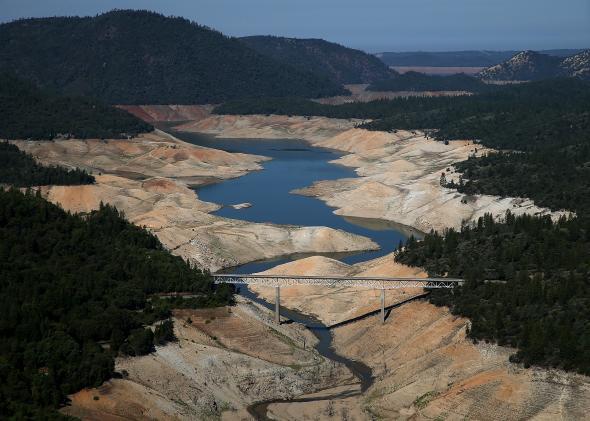On Monday, the NOAA released a new report examining the origins of the weird weather that’s led to California’s drought—which, by one estimate, is the region’s worst in at least 1,200 years.
The NOAA study attempted to attribute a root cause to the lack of rainfall. Was it natural? Was it global warming? The results found that the main drivers were a mix of persistent Pacific Ocean temperature patterns and the randomness of the atmosphere, or “internal variability.” Some are taking this to mean that climate change didn’t significantly impact the drought.
“Nature, not climate change, blamed for drought,” said the San Francisco Chronicle. “California drought is said to have natural cause,” reported the New York Times. And USA Today said, “Causes of Calif. drought natural, not man-made: NOAA.”
But that interpretation is misleading.
I hope that in all my writing on this topic, I’ve never said or implied that any specific weather or climate event was definitively caused by climate change. That fact is almost impossible to know—even more, it’s probably dangerous to even ask it. The atmosphere just doesn’t work in cause and effect. It’s a huge, dynamic system, and everything affects everything else. The research has convinced me that the drought probably had an origin in natural variability of the climate system. But I also still believe—and don’t think that these are mutually exclusive—that global warming nevertheless contributed, perhaps substantially, to California’s current drought.
Even if the “cause” is natural, we can’t ignore the role that climate change likely plays in exacerbating the situation. Warming increases the rate of evaporation, increases the need for irrigation and groundwater pumping, and reduces snowpack. Droughts like this can also be self-sustaining, as drier soils lead to higher temperatures. Monday’s study didn’t address this part of the equation.
But in an email conversation with Slate, Richard Seager, the lead author of the NOAA report, argued that the impact of rising temperatures on California’s drought was minimal.
“Our report did not pay much attention to [temperature],” Seager said, but then downplayed its importance, adding, “the future will not look like this particular drought.” He linked California’s record temperatures to human-caused climate change but said even that “cannot account for much of the high temperatures that occurred this past winter. So, all in all, the drought was primarily a natural event.”
Again, even if the exceptional dryness over the last three years was proximately due to random atmospheric fluctuations, that doesn’t address the long-term issue that California has with its increasing reliance on dwindling snowpack and the overdrawn Colorado River. No reasonable person could say with a straight face that California’s drought impacts aren’t worse because of human-caused climate change. And, of course, it’s the impacts that affect people’s lives, not which high-pressure system was shifted in what direction for how many months.
I spoke by phone with Peter Gleick, a hydroclimatologist and president of the Pacific Institute in Oakland, California, who coincidentally wrote a useful blog post review about how climate change is impacting California’s drought just a few hours before Monday’s NOAA report was released.
“The day may come when we know enough to talk about causality [of climate change on extreme events], but I certainly don’t think we’re at that point yet,” Gleick said. “I do think we’re at the point where influence is clear.”
One of Gleick’s main criticisms of the NOAA study was that “they completely ignored the temperature question, which is by far the clearest signal.” He continued, “There’s just no dispute that temperatures globally are going up. There’s no dispute that temperatures regionally in California are going up. There’s no dispute that the last three years have been the hottest in the instrumental record [in California]. And, there’s no dispute that hotter temperatures increase water demand in California. The exact same drought with normal temperatures is not as bad.”
Basically, he says, “I think [the authors of the NOAA study] were answering correctly the wrong question.”
Gleick noted that another study by the same authors of Monday’s NOAA report sounds completely different from Monday’s media coverage. Here’s a quote he pulled from that paper, published in June: “Long-term changes caused by increasing trace gas concentrations are now contributing to a modest signal of soil moisture depletion, mainly over the U.S. Southwest, thereby prolonging the duration and severity of naturally occurring droughts.”
So before you go out and buy an SUV this afternoon in Rancho Cucamonga in celebration of California’s liberation from the clutches of climate change, remember that Monday’s NOAA report was only one study, and at odds with others published earlier this year by the same authors.
